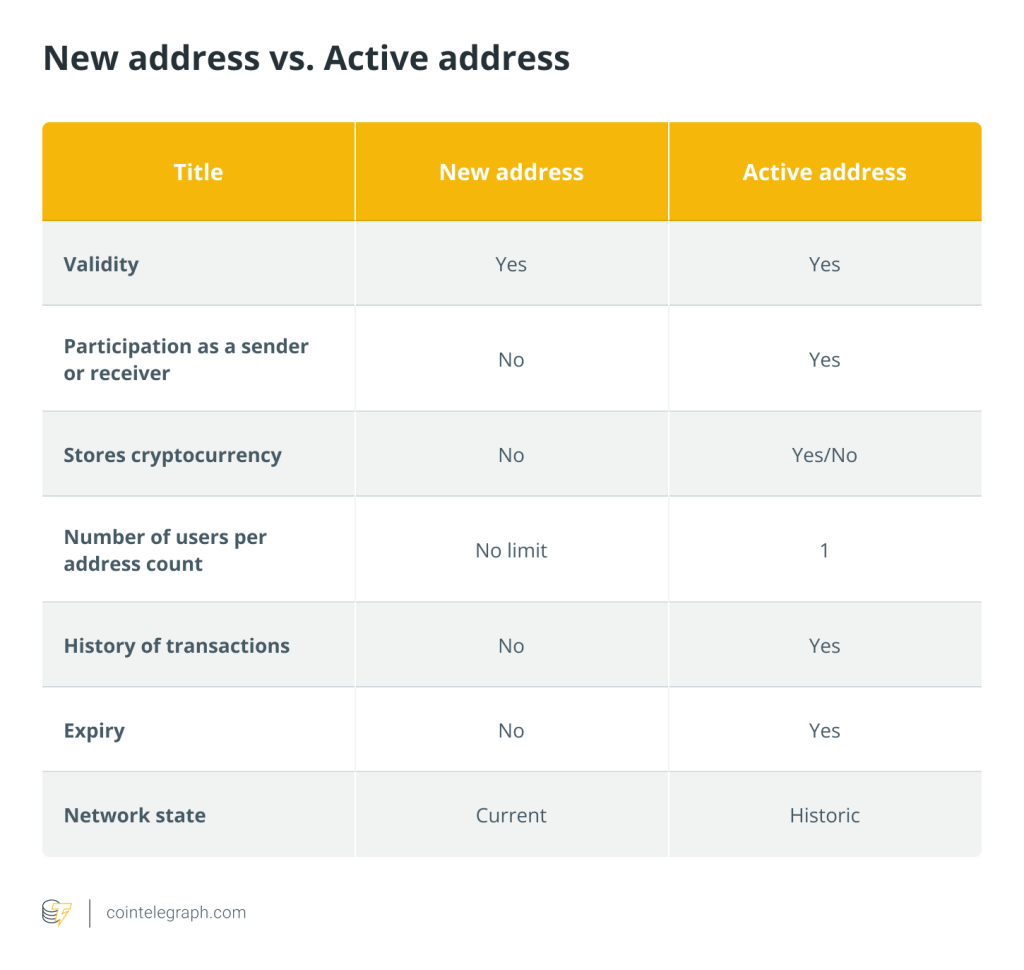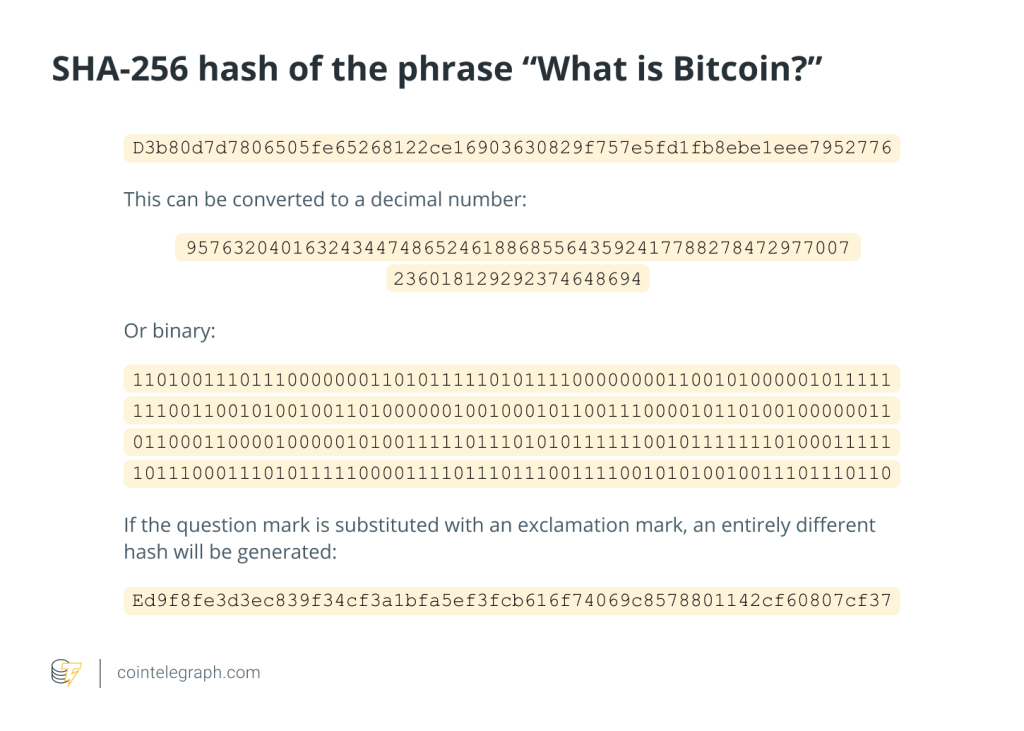Active vs. new addresses in crypto: Key differences explained


Understanding crypto addresses and their various states
In the world of crypto, addresses play an important role in helping to store and transfer cryptocurrencies over a blockchain network. An address acts as a unique identifier of a crypto wallet, which can be shared publicly for transacting cryptocurrencies.
While predominantly used to send and receive cryptocurrencies, understanding the behavior and current state of a crypto wallet uncovers holistic insights about the ecosystem, its users and long-term sustainability based on historical data.
Crypto addresses play a very important role in providing uniqueness to each user and ensuring the successful transfer of funds between two parties.
In this article, we take a good look at crypto addresses, how they work, where to find them and finally, how to identify the significance of the states of the wallet addresses.
What is a crypto address? How does a crypto address work?
When a crypto wallet is created, for every token it supports, a unique address gets assigned to the wallet. This address is crucial for making sure the sender can send cryptocurrencies to the intended recipient.
A typical wallet address is represented by a unique string of alphanumeric characters, i.e., a combination of numbers and alphabets. The string (Base58) is derived from the hashed version of the crypto wallet’s public key and a checksum to avoid mistyping.
The length of a Bitcoin (BTC) address is usually between 26–35 characters long, which can also be represented by a QR code. Digital wallets and platforms provide for copy/pasting the addresses easily to ensure accuracy. One can simply scan the QR code or use the corresponding address to send and receive tokens over a public blockchain.
For receiving cryptocurrencies on a particular wallet, a user shares the corresponding wallet address. If the sender sends cryptocurrencies to an unsupported wallet, the user may risk permanently losing the sent tokens.
To find out more about storing cryptocurrencies, check out Cointelegraph’s detailed take on storing crypto in 2022.
How to find/locate my crypto wallet address?
Locating the address of a crypto wallet is a simple two-step process. Once a user successfully creates a crypto wallet, it comes with two unique addresses that can be used for either receiving or sending cryptocurrencies.
To view the crypto address, go to your wallet and click on either send or receive. In the next step, the user will be greeted with the wallet’s corresponding address in the form of a scannable QR code or a string of numbers and letters — also known as the address.
In the case of hardware or paper wallets, users may get a physical printout of the QR code, which can be stored in traditional fiat wallets and shared with others for receiving cryptocurrencies.
The various states of a crypto wallet address
The state of a wallet address is determined purely by the last time it was used for successfully transacting — sending or receiving — cryptocurrencies. Depending on their current state, crypto wallet addresses fall under three broad categories; namely, active, new and dormant addresses.
The current state of crypto addresses helps in understanding the overall activity of the network. However, neither an active nor a new address can indicate the number of unique users as there are no hard limits to the number of crypto wallets or addresses an individual can create and operate.
On the other hand, gauging the current state of the addresses provides insights into the network participation and support from other crypto investors. The steady growth in the number — of both new and active wallet addresses — is a fair indication of the health of the system.
Below, we discuss the various nuances of active and new addresses in detail:
Active addresses
An address is considered active as soon as it becomes a direct participant in a successful transaction — either as a sender or a receiver. As a result, active addresses serve as a good indicator of daily users over any particular blockchain. In other words, active addresses represent the total number of active users on the network.
For example, monthly active addresses represent all the users that either sent or received cryptocurrency over that particular month. However, a particular address is counted just once over any timeframe, even if it has been an active participant in two or more transactions.
To be considered an active address, one must be a participant in an on-chain transaction — a successful crypto transaction that is recorded and can be confirmed over a blockchain. On-chain transactions are always recorded on all blockchain networks, which include public blockchains, private blockchains, consortium blockchains and hybrid blockchains.

On the other hand, participants of off-chain transactions do not qualify for being considered as active addresses. This is because off-chain transactions are not recorded over the blockchains like on-chain transactions. Rather, they rely on the traditional P2P means of transfer including exchanging private keys and linking them to a new wallet.
Does price cash lead to fewer active addresses?
Yes, the price crash could be one factor in the dramatic drop in the active addresses. It is because when crypto prices begin to fall, most investors attempt to exit the market.
On the other hand, people who purchased at a low price would want to preserve any profits available before the price fell much lower, i.e., by selling their crypto holdings and converting them to fiat currency.
In addition to the above, some people tend to exit the market to avoid bearing losses during a market meltdown. Investing may be a rollercoaster of emotions and not everyone wants to be a part of it. Selling coins is usually the pleasing solution for folks who can't keep their emotions out of the game. As a result of the wildly shifting prices, some investors would dump coins solely based on their feelings, leading to fewer active addresses.
For instance, the number of active addresses on the Bitcoin network fell by nearly 60% in July 2021, from 1.3 million to roughly 500,000. The more than 50% sell-off that followed Bitcoin's all-time highs in May 2021 and following sideways market action, as well as the significant decline in network hash rate during China's crackdown on local Bitcoin mining companies, may be contributing to the dramatic drop in active Bitcoin addresses.
New addresses
A new address in crypto relates to the creation of a new wallet address over an active blockchain. A crypto address is protected with a combination of private and public keys that algorithmically links to the corresponding wallet based on the specific blockchain. For this reason, an address that supports ERC-20 tokens will not be able to receive TRX-20 tokens and the sender may risk permanently losing the funds. In case you end up sending tokens to an unsupported wallet by mistake, it may be possible to recover the assets by adding a supported smart chain network to that wallet in some cases.
To generate a new crypto address, one must have an active wallet, which can be obtained either from wallet service providers such as exchanges and software and hardware wallets.
A new crypto wallet address has no previous history of transactions. In some cases, crypto exchanges automatically generate new addresses after every successful transaction. This prevents other users from checking past transactions or tracking the funds — thus preserving anonymity.
Due to the reasons stated above, a new address does not represent the actual number of users signing up for a new crypto wallet. It is also important to note that a new address can change its current state to become an active address. But the opposite is not possible.
Key differences: New address vs. Active address

Determining active vs. new crypto addresses
Historically, crypto addresses have been used to gain a fair understanding of the network and gauge the activities of the participants.
An address is considered new from the time it gets created until it becomes an active participant in a successful transaction. Upon a successful transaction as a sender or receiver, the address can either have an active or an inactive state depending on the timeframe used.
Only on-chain transactions can be considered for determining active addresses on a blockchain network. Off-chain transactions are not considered as these transactions are not recorded over the blockchain.
In any given timeframe, an active address can be counted just once even if it participates in more than one successful transaction. A new address does not determine the total number of users within a blockchain network.
If you are planning to start investing in cryptocurrencies, we recommend checking out Cointelegraph’s guide on storing BTC.






… [Trackback]
[…] Read More on to that Topic: x.superex.com/academys/beginner/3146/ […]
… [Trackback]
[…] Read More on on that Topic: x.superex.com/academys/beginner/3146/ […]
… [Trackback]
[…] Read More on on that Topic: x.superex.com/academys/beginner/3146/ […]
… [Trackback]
[…] Information to that Topic: x.superex.com/academys/beginner/3146/ […]
… [Trackback]
[…] Read More Information here on that Topic: x.superex.com/academys/beginner/3146/ […]
… [Trackback]
[…] Find More Information here to that Topic: x.superex.com/academys/beginner/3146/ […]
… [Trackback]
[…] Find More to that Topic: x.superex.com/academys/beginner/3146/ […]
… [Trackback]
[…] Find More here to that Topic: x.superex.com/academys/beginner/3146/ […]
… [Trackback]
[…] There you will find 35779 additional Information on that Topic: x.superex.com/academys/beginner/3146/ […]
… [Trackback]
[…] Info on that Topic: x.superex.com/academys/beginner/3146/ […]
… [Trackback]
[…] Info on that Topic: x.superex.com/academys/beginner/3146/ […]
… [Trackback]
[…] Find More on on that Topic: x.superex.com/academys/beginner/3146/ […]
… [Trackback]
[…] Information on that Topic: x.superex.com/academys/beginner/3146/ […]
… [Trackback]
[…] Here you can find 96008 additional Information to that Topic: x.superex.com/academys/beginner/3146/ […]
… [Trackback]
[…] Information to that Topic: x.superex.com/academys/beginner/3146/ […]
… [Trackback]
[…] Here you will find 57676 additional Info on that Topic: x.superex.com/academys/beginner/3146/ […]
… [Trackback]
[…] Find More on that Topic: x.superex.com/academys/beginner/3146/ […]
… [Trackback]
[…] Find More here on that Topic: x.superex.com/academys/beginner/3146/ […]
… [Trackback]
[…] There you can find 93524 additional Information to that Topic: x.superex.com/academys/beginner/3146/ […]
… [Trackback]
[…] Read More Information here to that Topic: x.superex.com/academys/beginner/3146/ […]
… [Trackback]
[…] Read More to that Topic: x.superex.com/academys/beginner/3146/ […]
… [Trackback]
[…] Find More here to that Topic: x.superex.com/academys/beginner/3146/ […]
… [Trackback]
[…] Info to that Topic: x.superex.com/academys/beginner/3146/ […]
… [Trackback]
[…] Read More Information here to that Topic: x.superex.com/academys/beginner/3146/ […]
… [Trackback]
[…] Find More Information here on that Topic: x.superex.com/academys/beginner/3146/ […]
… [Trackback]
[…] Find More on that Topic: x.superex.com/academys/beginner/3146/ […]
… [Trackback]
[…] Information on that Topic: x.superex.com/academys/beginner/3146/ […]
… [Trackback]
[…] Read More Information here on that Topic: x.superex.com/academys/beginner/3146/ […]
… [Trackback]
[…] Info on that Topic: x.superex.com/academys/beginner/3146/ […]
… [Trackback]
[…] Find More Information here to that Topic: x.superex.com/academys/beginner/3146/ […]
… [Trackback]
[…] Here you can find 31968 additional Info on that Topic: x.superex.com/academys/beginner/3146/ […]
… [Trackback]
[…] Information on that Topic: x.superex.com/academys/beginner/3146/ […]